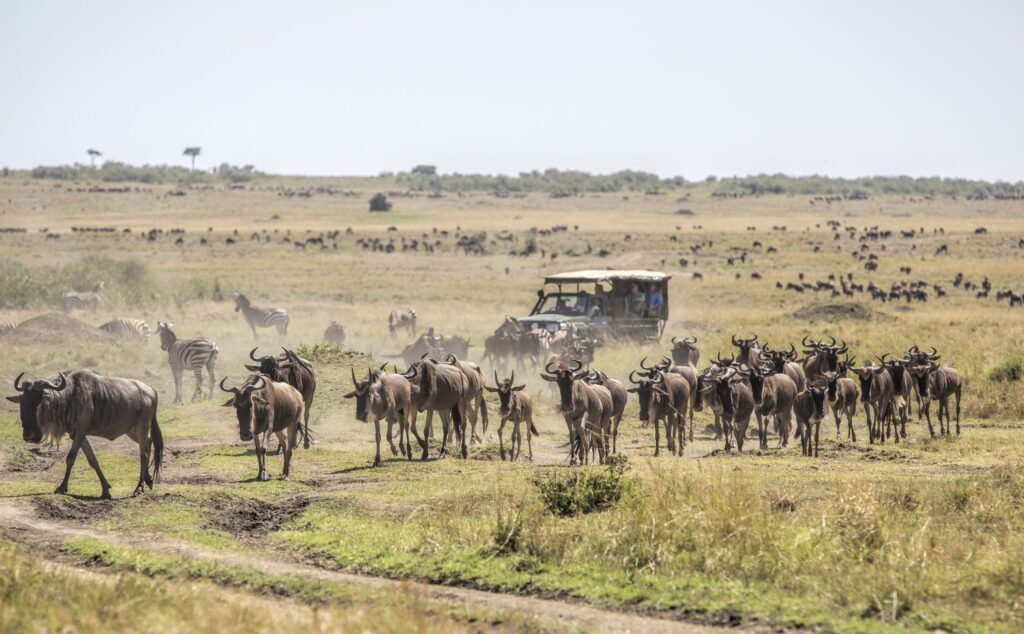Mara River
The Mara River, an essential element of the Serengeti and Masai Mara conservation habitats, is a distinctive watercourse traversing Narok County in southern Kenya, within the Masai Mara National Reserve, and extending into the Mara region of northern Tanzania. It is referred to as the ‘river of death’ because of its significance in the annual wildebeest migration. It originates in the Kenyan highlands and flows through the Masai National Reserve to the Serengeti National Park in Tanzania.

The Mara River, measuring approximately 395 kilometers in length and encompassing an area of 13,504 square kilometers, ultimately discharges into the Masai Mara National Reserve and extends into the Mara region of northern Tanzania. It is also designated as a river of death and plays a crucial role in wildlife migration. This river originates in the Kenyan highlands and traverses the Masai National Reserve before reaching the northern region of Tanzania, specifically the Serengeti National Park. The Mara River extends approximately 395 kilometers and has a drainage area of approximately 13,504 square kilometers. The Mara River flows into Lake Victoria.
This river is crucial to the yearly wildebeest migration in the Serengeti and Masai Mara national reserves. Nearly 2 million animals traverse this river in pursuit of new grazing grounds. The fauna in this region comprises wildebeests, zebras, and gazelles. To engage with this river, consult tour operators of the possible migratory dates. The wildebeest migration typically transpires from June to September.
What Wildlife inhabits the vicinity of the River?
During safaris to the Mara River, one will observe a diverse array of animals, including crocodiles and hippos, which are the most prominent species. The region hosts rhinos, elephants, buffalo, and numerous more species, rendering it a haven for wildlife aficionados.
What activities are conducted on safaris to the Mara River?
Numerous activities are available for participation during safaris to the Mara River, including the following:
Wildlife around Mara River
Game drives constitute a principal activity available during your vacation to the River. Along this river, one may observe a variety of species on safaris. During river safaris, various animal species are observed, including lions, leopards, buffalo, giraffes, wildebeest, rhinos, zebras, and impalas. Game drives along the Mara River often occur in the morning and late afternoon, when wildlife activity is heightened.
Walking safaris
Engage in walking safaris that facilitate interactions along the River. A ranger guide follows you to guarantee your safety during the trip. It requires you to experience various plants and creatures.
Hot air balloon expeditions
Balloon safaris provide an opulent experience. They enable aerial exploration of the Mara region. This sport endures for roughly one hour and offers breathtaking overhead vistas of the river and adjacent fauna.
Masai community excursions
The Masai community tours provide an immersive experience into the distinctive lifestyle of the Masai. This is a prominent indigenous community located in the Masai Mara National Reserve and Serengeti National Park. During your visit to these areas, you will engage in several activities including cultural dances, cow husbandry, bead crafting, traditional attire, folk music, and additional experiences.
What is the route to the Mara River?
A prevalent inquiry while organizing a safari is the method of accessing the river, which is reachable from both Kenya and Tanzania. The river in Tanzania is accessible via Serengeti National Park. Access to the Serengeti can be achieved by road or plane travel. Domestic chartered flights from Arusha facilitate connections to other airstrips in the Serengeti, including Seronera Airstrip. Opting for vehicle transport necessitates an extensive drive from Arusha to Serengeti National Park, approximately 8 hours to arrive at the river.
In Kenya, you may employ both road and air transportation to access the River. Traveling by vehicle from Nairobi to the river requires roughly 6 to 7 hours. Air transportation can be organized from Wilson International Airport to various airstrips within the reserve. This flight has a duration of approximately 45 minutes and caters to multiple airstrips, including Ol Kiombo, Angama Mara, Musiara, Keekorok, Kichwa Tembo, among others.
Lodging in proximity to the Mara River?
Diverse lodging alternatives are accessible for safaris to the Mara River, encompassing both economical and opulent choices. These comprise Mara River Camp, Soroi Mara Camp, Rekero Camp, and Mara Explore Camp.
When is the optimal time to visit the Mara River?
The Mara River is accessible throughout the year, though the optimal period is from June to September, aligning with the wildlife migration. Throughout this period, diverse fauna can be viewed.
